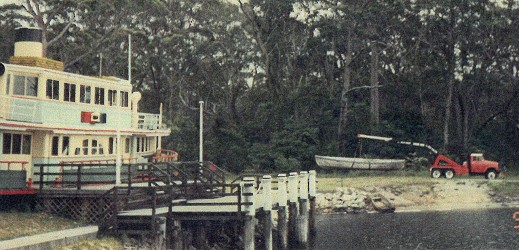| home | catalogue | history | references | appendix |
 |
surfresearch.com.au
jbwc : small wooden boat fleet, jbmm, 2015 |
Jervis Bay Whaleboat Crew ::
The Small Wooden Boat Fleet of the Jervis Bay Maritime Museum, 2015.
| Montagu Whaler | Era Surf-boat | Pedro | Warren |
|
|
Surf-ski | ... | [Sea-Bee] |
|
|
JBWC Project | JBWC Info | Whaleboat History |
Montagu Whaler
Montagu whalers were part of the standard boat fit-out of RAN ships from 1911 to the mid-1960's, this example is part of the Wooden Heritage Fleet of the Jervis Bay Maritime Museum, which serves as the case study for one of the last of these vessels and affords an opportunity to combine historical research with hands on experience.
Note that the common spelling of Montagu is without the e, the less occasionally used Montague has been adopted by the JBMM.
The vessel's significance to the Museum is substantial.
The Montagu Whaler's service for the Australian Navy parallels the life of the Museum's centrepiece, the Lady Denman ferry built locally in 1913, both crossing the waters of Sydney Harbour for over half of the 20th century.
.
The two vessels were acquired from HMAS Platypus for the Museum's collection largely by the efforts of Vera Hatton who, with her husband John, was instrumental in the Museum's foundation and ongoing success.
Furthermore, the boat is actually a combination of to two damaged boats (#872 and #1107), the extensive repairs and restoration performed by students from the Vincentia Public School under the expert supervision of Alf Settree, whose family had been building wooden boats on the on the banks of Currambene Creek since 1828.
The project was assisted by staff from HMAS Creswell and co-ordinated by Rex Williams for the Lady Denman Maritime Museum.
| The boat was rebuilt from
two badly deteriorated whalers
obtained from HMAS Penguin,
Balmoral, Sydney. It is landlocked due to its rarity. The rebuilding was completed by students of Vincentia Public School in 1993-94 under the supervision of well known local shipwright, the late Alf Settree. Montague Whalers date back to the 1890s whaling trade. Being double ended they were used in the later stages of a whale hunt & could be rapidly rowed away from a harpooned whale, preventing injury or death to the crew. The Australian Navy used whalers as general purpose boats until the mid 20th century when they were replaced by motor-powered craft. Montague Whalers and their American counterparts, New Bedford Whalers, are now relatively rare. |
 Ex-RAN Whaler being
restored for the Lady Denman Museum
at Vincentia Public School, 1993. |
Era Beach Surfboat
| Constructed in the
1920s, this unique vessel was used to
ferry passengers and goods to Era Beach, in the Royal
National Park. Clinker-built, it was initially pulled by oars, with an engine installed later. While it is currently impossible to fully investigate and assess the vessel's condition, preliminary research indicates that warrants entry on the AHVR. Right: Surf-boat, Era Beach circa 1940. |
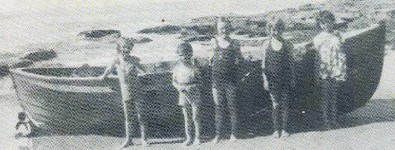 |
Pedro
JBMM CMC Notes
History Details: Built in 1960 by La Perouse Shipwright, Peter Weber, using Queensland maple and cedar from the Nowra area.
Pedro sailed on the Shoalhaven River for eight years.
Was found on a farm in 1984 by Trevor Fryar.
Fryar rebuilt tbe vessel with the help from his son Shannon, and sailed the boat for another four years before donating it to the Lady Denman Heritage Complex in 1994.
Descriptions Skiff with rudder and 1 centre board, one fixed and one loose. 12' wood varnished.
Maker's marks. [nil]
| The Pedro
is one of only two sailing boats in
the JBMM heritage fleet, the other
being the Montague Whaler. A remarkably attractive vessel, she was constructed in 1960 in Queensland maple and Shoalhaven cedar, restored in 1984 and donated to the Lady Denman Heritage Complex in 1994. Unfortunately, the actual design or class of the Pedro is yet to be identified. The general condition of the boat is excellent, although there is some major scuffing along the port gunwale. Of major concern is the centreboard, which has had a 12'' (30 cm) section sawn off one end, which is fortunately still present. The rigging is in disarray, some of the shackles are missing, they have been replaced with synthetic twine and the rig needs considerable modification and/or adjustment. There are no sails. The new dolly built by the JBWC in August is substantially more robust than the previous frame and, importantly, it has be constructed so that the rudder can now be properly affixed. The re-rigging of the Pedro and alternatives and difficulties in professionally restoring the centreboard to its original condition are to be explored by the JBWC in 2016. Right: Pedro dolly Number 1. |
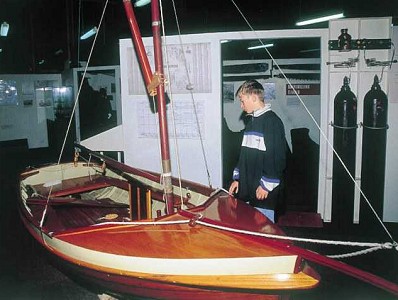 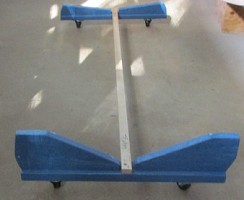 |
Warren
| The
museum has four
examples of clinker,
or lap-strake
construction, the Warren
being the smallest. This construction technique, dating from the Viking long ships of the first century AD, is also used in Montague Whaler and the Era Beach Surf-boat. The boat is solid and in very good condition, and its presentation has been greatly improved with the construction of its new dolly by the JBWC in September. While the dolly still needs to be painted black, iIt is now possible to exhibit the craft with its restored and working Seagull outboard motor correctly mounted on the stern. The addition of the row-locks, oars, anchor and a petrol can considerably enhance the exhibit. |
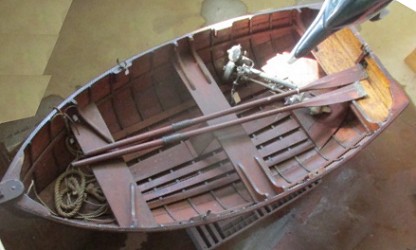 |
Tony Davis
PO Box 445 Nowra 2541
Davis & Herbert Narooma Pty Ltd
50
BTU Rd, Falls Creek, NSW, 2540
(02) 4447 8424 William Fisher La Perouse 1950s
Fisher Bros. Sydney 1950
http://www.ssec.org.au/our_environment/our_bioregion/kurnell/history/enterprises/fishing.htm
Several of the professional fishermen of 50 years ago had served their time as boat builders.
In slow fishing periods they were able to turn their hand to their craft.
The Fisher family, who owned and ran the ferries, built them at La Perouse.
They also towed a boatshed from Sydney Harbour on a punt and re-erected it adjacent to Silver Beach Road in the 1920s.
Bill Fisher built skiffs in this shed that has withstood all storms.
It has been used for a sailing club, for seaweed harvesting and for boat building.
Peter Bracken rented it and built his boats there before moving into his own shed in Ward Street.
Today it is owned by Pete McWilliams, a retired professional fisherman who bought it from Bill Fisher in 1960 and continues to build boats there.
Peter Bracken Boats
http://brackenboats.net/peters-story/
Circa 1948: Bill Fisher built wooden boats and also operated the ferry service between La Perouse and Kurnell along with his brother Jac, his son Jimmy and a local Aborigine named Gussy Sherett.
While at home on a Saturday morning I went out to La Perouse where Bill had his boat building and ferry operation.
During the course of a conversation with him, Bill (“Father” as everyone called him) said to me “You don’t want to go back to Nambucca do you?” and I agreed.
So I started work with him on the following Monday morning, completing my boatbuilding apprenticeship with him over the next two years.
It was a great time at La Perouse; interesting work, great people, building trawlers, ferries and island plantation boats.
Plywood Canoe
Surf-Ski
Sea-Bee Runabout (not a small wooden boat).
| This boat is on the Australian Historic
Vessels Register. By definition, the aluminium Sea-Bee is strictly not part of the JBMM's Small Wooden Boat Fleet. However, some observations can be made. The condition of the vessel is poor, particularly the timber deck. Now totally lacking any of the original varnish, similar to the surf-ski, it is likely to further deteriorate. Apparently, at some point, an attempt was made to (inexpertly) restore the hull, and the paint work is variegated and haphazard. The steering cables are in some disarray and the controls for the outboard motor have separated from the gunwale, and need remounting. Currently stored on tables and supported by bolsters, the boat requires a suitable dolly. Alternatively, its relative light weight could enable it to be exhibited in a similar manner to the surf-ski, as discussed above. |
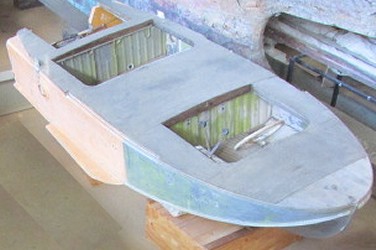 |
1960s McCulloch 14.5 HP Outboard
1970s Johnson 20 HP Outboard
Johnson Outboards
1966 FD-20
1967 FD-FDL-21
1968 FD-FDL-22
1969 20R69-20RL69
1969 20R69-20RL69
1970 20R70-20RL70
1971 20R71-20RL71
1972 20R72-20RL72
1973 20R73-20RL73
Balmain
Bug
http://themodelyacht.com/forum.htm
http://themodelyacht.com/forum.htm
History: The Whaleboat
Catalogue: JBMM Montagu Whaler #600
Jervis Bay Whaleboat Crew : Project
JBWC : Information for Members
| home | catalogue | history | references | appendix |
